
A | B | C | D | E | F | G | H | CH | I | J | K | L | M | N | O | P | Q | R | S | T | U | V | W | X | Y | Z | 0 | 1 | 2 | 3 | 4 | 5 | 6 | 7 | 8 | 9

Presidents of the United States have frequently appeared on U.S. postage stamps since the mid-19th century. The United States Post Office Department released its first two postage stamps in 1847, featuring George Washington on one, and Benjamin Franklin on the other. The advent of presidents on postage stamps has been definitive to U.S. postage stamp design since the first issues were released and set the precedent that U.S. stamp designs would follow for many generations.
The paper postage stamp itself was born of utility (in England, 1840), as something simple and easy to use was needed to confirm that postage had been paid for an item of mail. People could purchase several stamps at one time and no longer had to make a special trip to pay for postage each time an item was mailed. The postage stamp design was usually printed from a fine engraving and were almost impossible to forge adequately. This is where the appearance of presidents on stamps was introduced. Moreover, the subject theme of a president, along with the honors associated with it, is what began to define the stamp issues in ways that took it beyond the physical postage stamp itself and is why people began to collect them. There exist entire series of stamp issues whose printing was inspired by the subject alone.
The portrayals of Washington and Franklin on U.S. postage are among the most definitive of examples and have appeared on numerous postage stamps. The presidential theme in stamp designs would continue as the decades passed, each period issuing stamps with variations of the same basic presidential-portrait design theme. The portrayals of U.S. presidents on U.S. postage has remained a significant subject and design theme on definitive postage throughout most of U.S. stamp issuance history.[1][2]
Engraved portrayals of U.S. presidents were the only designs found on U.S. postage from 1847 until 1869, with the one exception of Benjamin Franklin, whose historical stature was comparable to that of a president, although his appearance was also an acknowledgement of his role as the first U.S. postmaster general. During this period, the U.S. Post Office issued various postage stamps bearing the depictions of George Washington foremost, Benjamin Franklin, Thomas Jefferson, Andrew Jackson, and Abraham Lincoln, the last of whom first appeared in 1866, one year after his death. After twenty-two years of issuing stamps with only presidents and Franklin, the Post Office[3] in 1869 issued a series of eleven postage stamps that were generally regarded by the American public as being abruptly different from the previous issues and whose designs were considered at the time to be a break from the tradition of honoring American forefathers on the nation's postage stamps. These new issues had other nonpresidential subjects and a design style that was also different, one issue bearing a horse, another a locomotive, while others were depicted with nonpresidential themes. Washington and Lincoln were to be found only once in this series of eleven stamps, which some considered to be below par in design and image quality. As a result, this pictographic series was met with general disdain and proved so unpopular that the issues were consequently sold for only one year where remaining stocks were pulled from post offices across the United States.[2][4][5]
In 1870 the Post Office resumed its tradition of printing postage stamps with the portraits of American presidents and Franklin but now added several other famous Americans, including Henry Clay, Daniel Webster, Alexander Hamilton and General Winfield Scott among other notable Americans.[1][2] Indeed, the balance had now shifted somewhat; of the ten stamps issued in 1870, only four offered presidential images. Moreover, presidents also appeared on less than half of the denominations in the definitive sets of 1890, 1917, 1954 and 1965, while occupying only a slight majority of values in the definitive issues of 1894–1898, 1902 and 1922–1925.
Presidential images did, however, overwhelmingly dominate the definitive sets released in 1908 and 1938: on the former, 10 of the 11 stamps offered the same image of Washington, while in the 1938 "prexies" series, 29 of the 32 stamps presented busts of presidents. The 1975 Americana Series marked a clear end to this tradition, being the first U.S. definitive issue on which no presidential portrait appeared; and presidents played only a minor role in the subsequent Great Americans series.
Every deceased U.S. president as of 2023[update] has appeared on at least one U.S. postage stamp, and all but Richard Nixon, and the two most recently deceased presidents, Gerald Ford, and George H. W. Bush, have appeared on at least two. Per postal office regulations, no living figure is permitted to be the subject of a postage stamp, so no living president is permitted on a postage stamp.
First appearances
The portrayals of various American presidents made their first appearances on U.S. postage at different times for very different reasons. Among the most definitive is George Washington, whose engraving (along with that of Benjamin Franklin) appeared on the first U.S. Postage stamps released by the U.S. Post Office, on July 1 of 1847. Thomas Jefferson first appeared on U.S. postage in March 1856, nine years after the first issues were released. Fifteen years of stamp issuance would pass before Andrew Jackson would appear on a U.S. postage stamp. However, by this time, Jackson had already been presented on two Confederate stamps (both 2-cent values), making him the only U.S. president introduced to postage by the Confederacy rather than the U.S. Post Office. Abraham Lincoln appeared for the first time on a U.S. postage stamp with the issue of 1866, released on April 14, 1866, the first anniversary of his death. Up until this time only the portrayals of Washington, Franklin, Jefferson and Jackson were found on U.S. postage.[1]
 George Washington Issue of 1847 |
 Thomas Jefferson Issue of 1856 |
 |
 Abraham Lincoln Issue of 1866 |
- The First Washington postage stamp. The 5-cent Franklin and the 10-cent Washington postage stamps issued in 1847 were the first postage stamps issued and authorized for nationwide postal duty by the U.S. Post Office. The firm of Rawdon, Wright, Hatch, and Edson of New York City were given a four-year contract to print the first U.S. postage stamps in 1847. The initials: "RWH&E" are clearly engraved at the bottom of both stamps. The engraving of Washington is identical to the one by the portrait engraver Asher Brown Durand on a Bank-Note issued by Fairfield County Bank of Connecticut, during a period when many banks issued their own forms of paper currency.[6] Both the Washington and Franklin issues were reprinted in 1875 from re-engraved images subtly different from the originals.[2]
- In March 1856 the Post Office issued the first postage stamp to feature Thomas Jefferson. The exact date of issue is not clear. Scott Specialized Catalogue of United States Stamps and Covers establishes the release date with the first known use of this issue, March 24, 1856. The first issue of this stamp was in imperforate form, engraved and printed by Toppan, Carpenter, Casilear & Co. The Jefferson issue saw postal duty from the spring of 1856 to the summer of 1857. The engraving of Jefferson was modeled after a portrait of the president by Gilbert Stuart. By mid-1857 the stamps were issued with the top and bottom design projections omitted and with perforations. This printing was issued in at least six major color variations.[7]
- On July 1, 1863, the Post Office issued the 2-cent Jackson stamp, commonly referred to by collectors as the 'Black Jack' stamp. Printed by the National Bank Note Company, it was released on the same day the new drop letter rate (the fee for mail delivered within city limits) was raised to two cents.[8] Jackson is the third U.S. president to be honored on U.S. postage.[2]
- On or near April 14, 1866, one year after Lincoln's assassination in 1865, the U.S. Post Office issued its first postage stamp honoring the fallen president. The engraving of Lincoln was rendered by Joseph Ourdan after a photograph by C.S. German.[9]
George Washington

This engraving was modeled after a bust of Washington by renowned French sculptor Jean Antoine Houdon.
George Washington (February 22, 1732 – December 14, 1799) was the first president of the United States, serving from 1789 to 1797, and before this, served as the commander of the Continental Army in the American Revolutionary War from 1775 to 1783. The Electoral College elected Washington unanimously in 1789, and again in the 1792 election; To this day George Washington remains the only American president to have received 100 percent of the electoral votes. Washington took his oath of office while standing on the balcony of Federal Hall on Wall Street in New York City.[10][11]
The chronology of presidents on U.S. postage begins with George Washington. Near the end of Washington's second term as president, Martha Washington commissioned the well-known portrait artist Gilbert Stuart to paint both her portrait and the president's. Stuart was known for the length of time it took him to complete a painting, and consequently neither the president nor his wife ever saw the finished paintings. The two portraits remained unfinished and tacked to a door in Stuart's Boston studio until his death in 1828. In 1860, artist Rembrandt Peale finished Stuart's work, filling in where this artist had left off. Stuart's portrait of Washington[12][13] became the model image for a good number of postage issues of the 19th and 20th centuries.[14]
George Washington remains the central figure found on U.S. postage. The first president appears on the face of U.S. postage more than any other president. The engraved images of Washington found on the early issues set the precedent that all U.S. postage issues would follow in the following decades. Indeed, in virtually every U.S. definitive stamp series offered between 1851 and 1932, Washington appeared on the normal letter-rate value (the only exception being the short-lived 1869 pictorial issue); other presidents, statesmen and famous Americans were confined to the less commonly used denominations. Since the first U.S. postage stamp was issued by the U.S. Post Office, there have been more examples of George Washington appearing on U.S. postage than all other American presidents combined, including Thomas Jefferson, Andrew Jackson, Abraham Lincoln and even the frequently honored Benjamin Franklin (who was not president).[1] Examples of all the various Washington stamps are too numerous to include in this section, as many of the issues are very similar with only differences in color and denomination, such as the Washington–Franklin issues. Featured below are the issues that are unique in their designs and the most definitive.
Pre-history
When the U.S. Post Office issued its 10-cent Washington value of 1847 as part of the first U.S. national postage stamp release, Washington's image had already been appearing for five years on postage stamps printed in the U.S. by private letter-carrying services and by local postmasters. Indeed, the first postage stamp ever produced in the Western Hemisphere was a 3-cent issue bearing a somewhat crude engraving of Washington, introduced in 1842 by the City Despatch Post in New York City.

In 1845, the New York Postmaster issued a provisional stamp for local use which offered a far more elegant image of Washington, engraved by the firm of Rawdon, Wright and Hatch (the same company that, two years later, would produce the first National U.S. postage stamps). That year, Washington also appeared on a very rare 5-cent provisional issue offered by the post office in Millbury Massachusetts. Washington was the only president depicted on any of the postmasters' provisionals released during this period.
Classic period
Postage stamp designs of this period were typically taken from paintings and other works by famous artists that set the precedent for stamp designs in the ensuing years of American stamp production. Engravers from this period typically used the works of John Trumbull, Gilbert Stuart and Jean Antoine Houdon as models for their engravings.[7]
 Issue of 1851/1857 |
 Issue of 1851 |
 Issue of 1855 |
 Issue of 1860 |
 Issue of 1860 |
- On July 1, 1851, the U.S. Post Office issued a 3-cent postage stamp. Because of die recuts, double transfers from die to plate and different paper used for its printing, this issue comes in numerous varieties. The authoritative book on the issue, 'Classic U.S. Stamps 1845–1869' was written by Carroll Chase, published in 1962. Engraving of image taken from a sculpture by Jean Antoine Houdon. The Post Office did not produce perforated versions of this stamp until 1857.
- The Post Office released the 12-cent Washington on August 4 of 1851. The engraving of Washington is modeled after a portrait by Gilbert Stuart. When the 12¢ issue was printed the stamp was the highest U.S. denomination ever issued. The issue was printed by Toppan, Carpenter, Casilear & Co. A perforated version appeared in 1857.
- In 1855 the postal rate for mail bound for destinations over 3,000 miles was increased from 6 cents to 10 cents, a change that prompted the issue of the 1855 10-cent Washington stamp. This 10-cent green issue was printed by Toppan, Carpenter, Casilear & Co. who reused the engraving of Washington (the vignette) of the 12-cent Washington 1851 Issue for this 10-cent postage stamp. The engraving was modeled after Gilbert Stuart's portrait of Washington. A perforated version appeared in 1857.
- In 1857 printing plates were made for a 24-cent Washington issue, but the stamp itself was not produced until 1860; the earliest known date of usage is July 7.
- On August 13, 1860, the Post Office issued the Washington 90¢ issue. Washington's engraving was modeled after a portrait by John Trumbull, titled George Washington before the Battle of Trenton, painted in 1792. It was only issued in the year 1860 and because of its high denomination only 29,000 copies were made and surviving examples are scarce. There were very few occasions where the amount of postage required to mail an item cost as much as 90¢ and as a result, genuine postally used examples of this issue are worth about twice as much as unused specimens.[1][2]
Civil War era
Abraham Lincoln assumed office in March 1861 and just one month later the Confederate forces fired on Fort Sumter which marked the beginning of the American Civil War. Issued only months after the Battle of Fort Sumter, no other series of stamps issued during the Classic Period has such an important connection to American history as the 1861 National Bank Note Company Issues. As in the series issued between 1851 and 1860, Washington occurs five times in the 1861 group while Franklin occurs twice and Jefferson once.[1]
 Issue of 1861 |
 Issue of 1861 |
- The Post Office released the 10¢ Washington green issue on August 20, 1861. Washington's portrayal was engraved by William Marshall who employed Gilbert Stuart's unfinished portrait of the first American president for his model.[6]
- The 3¢ Washington of series of 1861 was issued on August 19, the same year. The engraved imagery was modeled after a bust of Washington by French sculptor Jean Antoine Houdon.[15]
 Issue of 1861 |
 Issue of 1862 |
 Issue of 1861 |
- 12¢ Washington issue of 1861. The National Bank Note Company was founded in 1859, and William Marshall was one of the first portrait engravers hired. By early 1860, Marshall was given the task of engraving Washington's portrayal for the 1861 Issue. He was sent to Boston to use Gilbert Stuart's portrait painting of George Washington as his model for the new engraving.[16]
- The 24¢ lilac was issued January 7, 1862. The engraving was taken from same Gilbert Stuart painting, although the image was reversed. The engraver was William Marshall, the same artist who produced the 10 and 12 cent Washington 1861 Issues. William D. Nichols and Cyrus Durand (inventor of the machine used to produce intricate lathe work in engravings) was the engraver of the stamp's frame work.[17]
- The 90¢ Washington stamp was issued in the last two weeks in August 1861 to only several post offices. The earliest known use on cover is November 27, 1861. The engraving of Washington was taken from the same John Trumbull portrait as was the issue of 1860.

- In 1869 the ill-fated 'pictorial issue' was released. Most of the stamp issues from this series featured scenes of various sorts. The Washington stamp of this series was criticized as much as the others but for its plain graphic features, like the checker background surrounding the vignette. The stamp format was designed by E. Pitcher while the engraving was modeled after a Gilbert Stuart portrait of Washington.[9]
- George Washington is also found on an 1863 Civil War issue of the Confederate States.[18]
After Civil War

by Jean Antoine Houdon
This sculpture served as the model for Washington engravings on a variety of postage issues of the late 19th century
The ending of the American Civil War marked a beginning in U.S. stamp subject and design change. The Union victory brought with it a strong American nationalism among the populace throughout the north and much of the country. This national sentiment was largely responsible for the various Civil War figures to appear on U.S. postage. Until 1869, with the one exception of Benjamin Franklin, only American presidents were found on U.S. postage. In April 1870, however, the images of Henry Clay, Daniel Webster, Winfield Scott, Alexander Hamilton and Oliver Hazard Perry appeared on new the 12¢, 15¢, 24¢, 30¢ and 90¢ stamps, and the following year Edwin M. Stanton, the U.S. secretary of war under Lincoln, appeared on a 7-cent postage stamp.[1][19]
1870s
The postage issued in the US during this time was printed by the National Bank Note Company (NBNCo) on white wove paper. The first printing was issued with 'grills', tiny cuts in the paper to absorb ink. Later reprintings were issued without grilling. The National Bank Note Company's contract expired in 1873, and the Continental Bank Note Company (CBNC) won the contract to continue printing the series and took over some of the dies and plates used by NBNCo. The new company employed secret marks on the lower-value stamps to distinguish its work from the first printing.[1][7] The green Washington 3¢ issue was printed in such large quantities that postally used examples remain inexpensive to this day, from pennies to a few dollars, depending on type of cancellation and condition. (The green variety was reprinted again by the American Bank Note Company (AmBNC), also in very large quantities, and issued on July 16, 1881.) The 3-cent Washington design was printed yet a fourth time, in vermillion, in 1887. The 3-cent issues paid the domestic letter rate for a half-ounce letter.[1]
The profile image of George Washington found on various postage issues of the late 19th century and early 20th century is modeled after a bust of Washington by the renowned sculptor Jean-Antoine Houdon. Several engravers of presidential portraits on U.S. postage have modeled their engravings after Houdon's sculptures.
 Issue of 1870 NBNCo |
Engraving taken from bust by Jean Antoine Houdon |  Issue of 1887 (reprint of 1870 issue) |
| Jean Antoine Houdon's portrait sculpture of Washington was the result of a specific invitation from Benjamin Franklin to come to the United States so that Washington could model for him. Washington sat for wet clay life models and a plaster life mask in 1785.[20] These models served for many commissions of Washington and eventually were used as models for the engravings of Washington on several US Postage issues of the 1870s, 1880s and 1890s. |
1880s
In 1883 the Post Office reduced the first-class letter rate from 3 cents to 2 cents for a half-ounce letter mailed within the continental United States, which Congress approved on March 3, 1883, effective October 1, 1883.[21] The Post Office immediately issued a 2-cent Washington stamp, so that the first president's image would remain visible on normal letters.
| Engraving taken from bust by Jean Antoine Houdon | ||
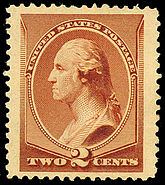 Issue of 1883 |
 Issue of 1883 |
 Issue of 1887 |
1890s
Stamp issues during the 1890s were first printed by the American Bank Note Company in 1890 and then by the Bureau of Engraving and Printing in 1894. The image for both issues was produced by an engraving that was modeled after a bust of Washington by sculptor Jean Antoine Houdon.[9]


- The American Bank Note 1890 issue, 2c, lake variety, Washington stamp (left) was issued on February 22, 1890, becoming the first stamp to be issued on a president's birthday.
- Bureau of Engraving and Printing issues, struck from the same dies as the ABN 1890 issues with minor changes in the frame work, three different styled triangles, known to collectors as the 'Bureau Triangles'. The 2¢ Washington paid the letter domestic letter rate and was printed in such large quantities that numerous color variations exist.[7][9]
Early 20th century
At the beginning of the 20th century, George Washington continued to be the most prominent subject depicted on the face of U.S. postage stamps. Washington would remain the most prevalent figure on U.S. postage for most of the 20th century. Only Benjamin Franklin is second to Washington, in part because Franklin is depicted on the numerous denominations of the Washington–Franklin series nearly as often as Washington.[22] Ironically, George Washington did not appear on a commemorative issue until 1925 when he was featured on a stamp commemorating another historical event.

- Issued on January 17, 1903, the 2¢ carmine red Washington postage stamp featured an engraving of Washington inspired and modeled after a painting by Gilbert Stuart which features a one quarter left image of Washington. R. Ostrander Smith designed the stamp. The vignette with its two American flags is often referred to as the Washington "Flag" stamp. Washington's portrait was engraved by George F. C. Smillie who engraved a variety of stamp images for the Bureau of Engraving and Printing. The 1903 issue is one among the second series of stamp issues that were produced that year by the Bureau.

- On November 12, 1903, because of public dissatisfaction with the 1903 2-cent Washington "Flag" stamp, the Post Office issued a new 2-cent stamp featuring Washington's portrait within a shield of stars and stripes. Often referred to as the 2-cent Washington "Shield" stamp, this issue was released on November 12, 1903. Along with the shield background, the left numeral is enclosed with laurel leaves while the number on the right is surrounded with oak leaves, symbolizing Washington's role as president in peace time and as general in times of war. Unlike the first 2¢ stamp of 1903, this issue was designed by Clair Aubrey Huston from a painting by Gilbert Stuart.[9] The engraving of Washington was done by George F. C. Smillie. The Washington "Shield" stamp is recognized for its many shade varieties, as collectors have distinguished over a hundred shades of this particular issue.[1]
Washington–Franklin Issues
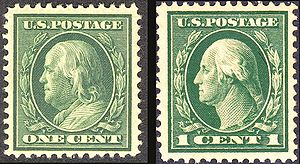
The Washington–Franklin Issues were unique in the sense that these subjects were the only ones found on definitive stamps for more than a decade. Beginning in 1908 the Washington–Franklin definitive stamps were issued over a twelve-year period in denominations ranging from one cent to five dollars, with different colors for each denomination, all with the same engraved profile of Washington or Franklin. While both Washington and Franklin occur on the 1-cent values, both in green, only one of them appears in a given series (Franklin on the issues until 1912), while the same Washington image graced the remaining eleven denominations, which ranged from two cents to one dollar. In later issues, Washington was present only on the seven denominations between one cent and seven cents, and all the higher values were assigned to Franklin. The engraving of Washington was modeled after a bust by the renowned sculptor Jean Antoine Houdon.[9] The few examples exhibited here are largely representative of this greater series. Franklin is displayed once here for general reference to the Washington–Franklin issues.
 Issue of 1908 |
 Issue of 1917 |
 Issue of 1909 |
- On January 29, 1909, the Post Office issued the 1-dollar Washington Head stamp. It was the last of the first issue of Washington–Franklin stamps to appear. The stamp remained on sale at Post Offices for more than three years before being replaced by a Franklin head 1-dollar stamp in 1912.[22] The one-dollar stamp is the highest denomination on which Washington appears in this series. Franklin is honored on the two- and five-dollar denominations.[23]

issue of 1911
Washington–Franklin issues chart
Washington on commemorative issues
Until the end of World War I, the Post Office, as a rule, issued commemorative stamps for only one reason: to promote a significant national exposition mounted by a U.S. city (the solitary exception to this practice was the Lincoln Memorial issue of 1909). The limited range of stamp subjects suitable to these trade fairs left no room for Washington's image on such commemoratives – even though he was the central subject of U.S. definitive stamps during these years. It was only after this restriction had been abandoned, in 1925, that Washington first appeared on a commemorative issue. This was twenty-one years after the Louisiana Purchase Exposition series, which had included the first three American commemoratives to honor specific presidents: Thomas Jefferson, James Monroe and William McKinley.[24]
 Washington at Cambridge Issue of 1925 |
 Washington at Prayer Issue of 1928 |
 Washington at Brooklyn Issue of 1951 |
- On the 1-cent stamp portraying the Lexington – Concord issue of 1925, Washington is shown leading the Massachusetts Militia at Cambridge against General Gage and the British regulars. This series was the first of many commemoratives celebrating the 150th anniversary of important events of the American Revolution. Like all issues of this period, this stamp was produced by the Bureau of Engraving and Printing.

Issue of 1939
- This 2-cent red postage stamp was issued on May 26, 1928. This commemorative honored the 150th anniversary of George Washington at Valley Forge and depicts him kneeling in prayer before the battle.
- The Post Office issued a 3-cent commemorative stamp, on December 10, 1951, at Brooklyn, New York, to commemorate the 175th anniversary of the Battle of Brooklyn. The stamp portrays the evacuation of General Washington's troops from Brooklyn at the site of the Fulton Ferry House, with an accurate depiction of the house and the flat-bottomed ferries used to cross the East River.
- On April 30, 1789, President Washington took the oath of office of the president of the United States. On the 150th anniversary of his inauguration, April 30, 1939, the Post Office issued a 3¢ commemorative stamp celebrating this event. The engraving depicts Washington standing on the balcony of the Federal Hall in New York reciting the oath of office.[10]
 Battle of Yorktown Issue of 1931 |
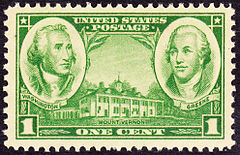 Washington Greene Issue of 1937 |
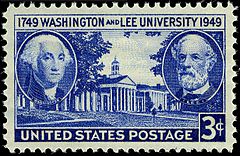 Washington, Lee & University Issue of 1949 |
- The 2-cent stamp issued on October 19, 1931, marked the 150th anniversary of the Battle of Yorktown (1781). This issue depicts Washington with Count de Rochambeau and Count de Grasse at his right and left, leaders of the French forces that aided in the victory of the American Revolution.

- The 1-cent Army Issue of December 15, 1936, features George Washington's home at Mount Vernon as its central design. Portraits of Washington and Nathanael Greene appear on either side of the image of Mount Vernon. Greene was one of Washington's most valued generals in the Revolutionary War.
- The 13-cent stamp Christmas Issue commemorates the 200th anniversary of Washington's army at Valley Forge, and was based on the J. C. Leyendecker painting George Washington at Valley Forge. Leyendecker's painting first appeared on the cover of the Saturday Evening Post on February 23, 1935. The stamp was designed by Steven Dohanos. The stamp was first available on October 21, 1977, at Valley Forge, Pennsylvania.[7]
1932 Washington Bicentennial
On January 1, 1932, in celebration of the 200th anniversary of George Washington's birth, the U.S. Post Office released its Washington Bicentennial Issue, a series of twelve postage stamps each with a different portrait of Washington. Each engraved portrayal was modeled from a different painting by an early American artist and the images present Washington at different periods in his life.[1][7] Engravings of Washington often depict his profile. In the 1932 Bicentennial anniversary series there are two issues that show Washington in profile, one facing left, the other facing right. Information regarding quantities issued can be found on the Washington Bicentennial Issue page.

The Washington Bicentennial issues of 1932 are the first commemorative postage stamps ever issued by the Post Office that honor and depict George Washington by himself, and not in conjunction with other people, places, or events as is the case with the three commemoratives with Washington's image issued before 1932.[2] There were 4.2 billion copies produced of the 2-cent Washington value in this series, a total that remains the largest stamp printing of a single issue ever to occur in U.S. postal history.[25]
Washington issues, middle 20th century
 Issue of 1923 |
 Issue of 1932 |
 Issue of 1938 |
- On January 15, 1923, the Post Office issued another 2¢ red Washington postage stamp as part of its new definitive series, thus continuing the tradition of honoring Washington on everyday-use postage. An existing engraving of Washington made for use on the Washington–Franklin issue was used. That engraving, done by Marcus Baldwin, was modeled from a bust made by Clark Mills in 1853, which, in turn, was a reproduction of a bust sculpted by Jean Antoine Houdon at Washington's Mount Vernon home in 1785. Clair Aubrey Huston designed the stamp's frame, which was engraved by Edward M. Hall and Joachim C. Benzing.[9]
- After the increase of the normal letter rate from 2 cents to 3 cents was announced in 1932, the Post Office acted to ensure that public would not be deprived of a definitive Washington stamp for its daily correspondence, a tradition that dated back more than sixty years. Rather than converting the 1923 definitive stamp to the new rate, the Post Office redesigned the 2 cent Washington Bicentennial value as a 3 cent regular-issue stamp, removing the original design's most conspicuous commemorative feature: the birth- and death-date ribbons flanking the portrait. This issue appeared on June 15, 1932, three weeks before the rate increase went into effect.[26]
- On April 25, 1938, the Post Office issued a green 1-cent George Washington stamp. It was the first stamp of the Presidential Issue of 1938, an issue that placed all of the deceased presidents in numerical order and thus represented a break with the long-standing tradition of reserving the normal letter-rate definitive stamp for Washington. Instead, this Washington issue saw postal duty carrying postcards and letters through the late 1950s. The 1938 Presidential Issue was Franklin Roosevelt's idea. An avid stamp collector, Roosevelt suggested a set of stamps that would pay tribute to the various past American presidents. In 1937, after much debate, a new definitive series was issued using Roosevelt's ideas. A national contest was held, with over 1200 entries submitted, the entry of a young New York City art student, Elaine Rawlinson, was chosen for the Washington stamp design.[7]
 Issue of 1954 |
 Issue of 1962 |
 Issue of 1966 |
- The Post Office released the 1-cent Washington stamp on August 26, 1954, in Chicago, Illinois. The engraving of George Washington was modeled from a portrait by Gilbert Stuart (1755–1828). It was designed by Charles R. Chickering, who produced his own drawing from a photograph he obtained from the National Gallery. The portrait of Washington was engraved by Richard M. Bower of the Bureau of Engraving and Printing.
- On November 23, 1962, the Post Office issued the 5-cent Washington stamp, first issued through the New York, New York, post office. Designed by William K. Schrage, the engraving of Washington, like several other engravings of this president, is based on a bust of Washington sculpted in 1785 by Jean Houdon.
- On February 22, 1966, the Post Office issued the 5-cent blue Washington stamp. Bill Hyde designed the stamp after a portrait by Rembrandt Peale. Critics described Washington's appearance on this stamp as "pockmarked" and "unshaven", and a smoother-looking re-engraved version was issued on November 17, 1967.[27]
Washington, recent issues
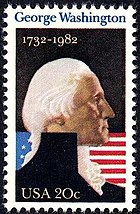

In recent years, Washington has appeared much less frequently on stamps than he did during the 19th and early 20th centuries.
- On the 250th anniversary of George Washington's birth, a 20-cent commemorative stamp was issued February 22, 1982, at Mount Vernon, Virginia. The First Day of Issue ceremony was held in the Mount Vernon Inn.[28] The designer, Mark English, of Kansas City, Missouri, based his design on a stylistic portrait depicting the distinctive Washington profile.
- The Postal Service issued a stamp on April 16, 1984, commemorating the 50th anniversary of the National Archives, and including silhouettes of Washington and Abraham Lincoln in the design.[29]
- Washington also appears on the AMERIPEX Presidential issue of 1986.
- On August 19, 1994, the U.S. Postal Service issued a 5-dollar Washington-Jackson stamp in Pittsburgh, Pennsylvania, at the American Philatelic Society's annual stamp exposition. The stamp was modeled after a design created in 1869 by the National Bank Note Company, which was originally prepared but never was used for the 1869 postage series. The central image or vignette features a portrait of George Washington and Andrew Jackson. The portrayals of Washington and Jackson were engraved through the intaglio process by Stamp Venturers, Inc., and issued in small sheets of twenty stamps.[7]
- In 2001, Washington appeared on a red-brown 20-cent definitive stamp, and the same Washington image was used that year for a 23-cent definitive stamp in dark green.
- The original Purple Heart, designated as the Badge of Military Merit, was established by George Washington, then the commander-in-chief of the Continental Army, on August 7, 1782.[30] The actual order includes the phrase, "Let it be known that he who wears the military order of the purple heart has given of his blood in the defense of his homeland and shall forever be revered by his fellow countrymen." Washington's profile adorns the modern Purple Heart medal, and the U.S. postage Purple Heart issue honors them both. Designed by Carl T. Herrman of Carlsbad, California, the stamp depicts an image of the Purple Heart medal with Washington in profile.[31] The Purple Heart stamp was first issued in 2003 with a 37-cent denomination. It was later reissued in 2006 as a 39-cent stamp, in 2007 as a 41-cent stamp, in 2008 as a 42-cent stamp, and on April 28, 2009, as a 44-cent stamp. Another Purple Heart stamp was issued on May 5, 2011, as a "forever" stamp.
- On April 11, 2011, the Postal Service issued a 20-cent stamp bearing a color reproduction of the famous Washington portrait by Gilbert Stuart.
John Adams

John Adams (October 30, 1735 – July 4, 1826) was the second president of the United States, serving from 1797 to 1801.
- The engraved portrayal of Adams (1735–1826) appears on the 2-cent value of the Presidential Issue, issued on June 3, 1938. Daniel Chester French's marble 1889 bust of Adams displayed in the U.S. Capitol's Senate Gallery was the model used for the engraving of Adams.
- Adams also appears on the AMERIPEX Presidential issue of 1986.
Thomas Jefferson

Thomas Jefferson (April 13, 1743 – July 4, 1826) was the third president of the United States, serving from 1801 to 1809.
Thomas Jefferson's likeness over the years has been finely depicted on the face of the various postage issues that honored him. The first issue to depict Jefferson was issued in 1856, (displayed above) nine years after the Post Office issued its first two stamps of Washington and Franklin in 1847. (Before this time hand-stamps were used to mark and confirm payment of postage.) Almost as popular and famous as George Washington, Jefferson appears comparatively less often on U.S. postage issues, and unlike Washington and Franklin, appears on just two commemorative issues, one in 1904, displayed below, the other on the AMERIPEX presidential issue of 1986. His remaining depictions are confined to regular issues.[24]
- On August 19, 1861, while the American Civil War was wreaking havoc across Virginia and elsewhere, the Post Office issued a 5-cent buff (yellow-brown) colored stamp that honored Thomas Jefferson. The engraving used to produce the image was modeled after a portrait by Gilbert Stuart. The engraver for this issue was William Marshall, who also engraved Washington's image for several issues of this period.[6] This Jefferson issue occurs in several distinct shades of brown. This image was again reprinted on February 3, 1863, in a dark brown color.[1] Also in 1861, Jefferson became the first U.S. president to appear on a Confederate stamp: a 10¢ value in blue, reissued in 1862 with its color changed to rose-pink.
 Issue of 1861 |
 Issue of 1870 |
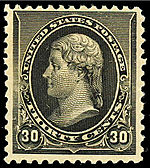 Issue of 1890 |
 |
- On April 12, 1870, the third stamp issued by the Post Office to honor Thomas Jefferson was released. The 10¢ stamp issue was printed by the National Bank Note Company. In 1859 the renowned sculptor Hiram Powers was commissioned by the US government to create two life-size marble statues to be placed in the United States Capitol building. One was of Benjamin Franklin; the other was of Thomas Jefferson, completed in 1863. This was the image Powers used to model his engraving of Jefferson on the 10¢ issue of 1870.[32]
- On February 22, 1890, the Post Office released a 30¢ postage stamp that once again honored Thomas Jefferson. The engraver and artist Alfred Jones (1819–1900) created the image of Jefferson that appears on the issue. Jones was noted for his engraved portraits and historic scenes during his time at American Bank Note Company.
- On November 1, 1894, the first 50¢ definitive Postage stamp was issued. It appeared in the first definitive series printed by the Bureau of Engraving and Printing. Its design is based on that of the 30¢ black issue of 1890, and employs the same engraved image of Thomas Jefferson by Alfred Jones. While largely identical in design, it is readily distinguished by its orange color, and by the triangles in the upper corners.
 Issue of 1903 |
 Issue of 1923 |
 Issue of 1938 |
- The second 50-cent orange stamp depicting Thomas Jefferson was issued March 23, 1903. The stamp was designed by R. Ostrander Smith from the 1805 a portrait of Jefferson by Gilbert Stuart. Jefferson's portrait was engraved by George F. C. Smillie.[9]
- Absent, of course, from the Washington–Franklin series, Jefferson returned to U.S. postage in the next definitive series (1923), depicted on a nine-cent stamp designed by Clair Aubrey Huston. Huston reused George F. C. Simille's engraving of Jefferson, which had appeared on the 2-cent value of the 1904 Louisiana Purchase Exposition Series. (The model for Simille's engraving was a portrait of Jefferson painted by Gilbert Stuart in 1805). Simille's engraving was transferred to a new die and restored by Bureau engravers John Eissler and Leo Kauffmann for use on the 1923 Jefferson issue.
- Jefferson appears on the 3-cent Presidential issue of 1938, which satisfied the normal letter rate. This was the first definitive U.S. series designed to place any president other than Washington on the normal-letter denomination.
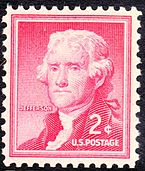 Issue of 1954 |
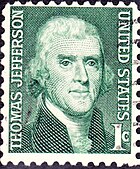 Issue of 1968 |
- On September 15, 1954, the 2-cent Jefferson stamp from the Liberty Issue was issued in San Francisco, California. The postcard rate went to 2 cents on the day of this issue was released so the stamp was very common among the mail for that reason. The engraving of Jefferson was taken from a portrait by Gilbert Stuart which hangs in the Bowdoin College Museum of Art in Brunswick, Maine.
- The 1-cent green stamp was issued January 12, 1968, at Jeffersonville, Indiana. The issue was designed by Robert Geissmann, modeled after an 1800 portrait of Jefferson by Rembrandt Peale which now hangs in the Blue Room of the White House. Edward R. Felver crafted the engraving of Jefferson.[9]
- The U.S. Postal Service issued the 29-cent Thomas Jefferson definitive stamp on April 13, 1993, in Charlottesville, Virginia. The stamp engraving features a portrait of Jefferson and is part of the Great Americans series. The stamp issue was designed by Christopher Calle while the die for the stamp was engraved by Stamp Venturers, Inc.
Jefferson on commemorative issue
Thomas Jefferson has only appeared on two U.S. commemorative issues, the first of which was released in 1904 and was one of the first three commemorative issues ever to honor U.S. presidents (along with Monroe and McKinley).[1]
Text je dostupný za podmienok Creative Commons Attribution/Share-Alike License 3.0 Unported; prípadne za ďalších podmienok. Podrobnejšie informácie nájdete na stránke Podmienky použitia.
Antropológia
Aplikované vedy
Bibliometria
Dejiny vedy
Encyklopédie
Filozofia vedy
Forenzné vedy
Humanitné vedy
Knižničná veda
Kryogenika
Kryptológia
Kulturológia
Literárna veda
Medzidisciplinárne oblasti
Metódy kvantitatívnej analýzy
Metavedy
Metodika
Text je dostupný za podmienok Creative
Commons Attribution/Share-Alike License 3.0 Unported; prípadne za ďalších
podmienok.
Podrobnejšie informácie nájdete na stránke Podmienky
použitia.
www.astronomia.sk | www.biologia.sk | www.botanika.sk | www.dejiny.sk | www.economy.sk | www.elektrotechnika.sk | www.estetika.sk | www.farmakologia.sk | www.filozofia.sk | Fyzika | www.futurologia.sk | www.genetika.sk | www.chemia.sk | www.lingvistika.sk | www.politologia.sk | www.psychologia.sk | www.sexuologia.sk | www.sociologia.sk | www.veda.sk I www.zoologia.sk
